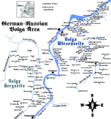Volga Germans facts for kids
Volga Germans (also known as Wolgadeutsche in German or povolzhskie nemtsy in Russian) were a group of people of German background. They lived along the Volga River in Russia. Even though they lived in Russia, they worked hard to keep their German culture, language, traditions, and religions. Many were Lutheran or Catholic.
Their story in Russia began when Catherine the Great, who was a German princess and became the Empress of Russia, invited Germans to move there. She offered them land and promised they could keep their language and way of life. This happened in the 1700s.
Later, in the 20th century, the Volga Germans even had their own special area called the Autonomous Socialist Soviet Republic of the Volga Germans. This region existed from 1924 to 1942, and its capital city was Engels.
Volga Germans in South America
Not all Volga Germans stayed in Russia. Many also moved to countries in Latin America, especially Argentina, Paraguay, and Brazil.
Most of the Volga Germans who settled in South America were Catholic. They often chose these countries because they shared the same Christian religion, which made it easier for them to feel at home and build new communities.
Images for kids
-
Ethnic Germans from the Volga region at a refugee camp in Schneidemühl, Germany, early 1920s
See also
 In Spanish: Alemanes del Volga para niños
In Spanish: Alemanes del Volga para niños









